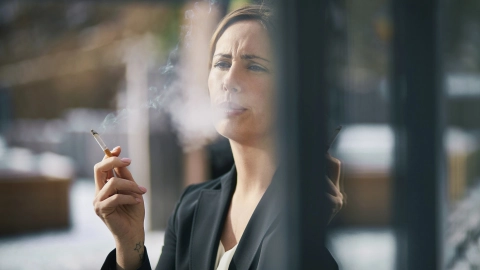Healthy living Medical drug abuse and dependency
ICD codes: F11 F13 F19 F55 What are ICD codes?
Older people and people with mental illnesses are vulnerable to taking medications in dangerous doses and becoming dependent on them. Read here about which substances are particularly addictive, how an addiction is treated, and how it can be prevented.
At a glance
- Drug dependency appears in people of all ages and social groups.
- Older women and people with mental illnesses, as well as those with other addictions, are often affected.
- It is easy to become quickly addicted to prescribed sleeping pills, sedatives, and painkillers.
- A person’s dependency can develop gradually, first starting as normal use that turns into harmful use.
- Treating a dependency involves withdrawal along with psychotherapy.
- Self-help groups and addiction counseling help to identify harmful consumption or dependency. In addition, they help to support long-term abstinence after withdrawal.
Note: The information in this article cannot and should not replace a medical consultation and must not be used for self-diagnosis or treatment.

What is medical drug abuse?
Doctors prescribe medications to alleviate specific symptoms and treat illnesses. That means that a prescribed medication is intended only for treatment of the illness for which it was prescribed.
Drug abuse is when a person
- takes a drug for an illness or symptoms for which it is not intended
- takes a drug at a higher dose than what was prescribed
- uses a drug for purposes other than those intended
- takes a drug for a longer period of time than prescribed
Harmful use is when physical or psychological consequences are already apparent.
A typical indicator of abuse is if a drug has harmful effects on the psyche or the body of the person taking it, or on other persons. If drug abuse continues over a long period of time, it becomes habitual and can result in drug dependency.
How common is medical drug abuse?
It is estimated that 2.7 million people in Germany between the ages of 18 and 60 take medication in harmful quantities or are dependent on them. Since the risk of drug dependency increases with age, the overall statistics are significantly higher.
Drug dependency appears in people of all ages and social groups. Older people are particularly dependent on sedatives, and women more often than men. Approximately two-thirds of all drug-dependent women are over 65 years of age.
However, the group of people more prone to dependency on opium-based painkillers are younger people between the ages of 20 and 40. Here, men are more often affected than women.
Mental illnesses and the concurrent use of sedatives and opioids in higher doses can also play a role in the development of a drug dependency.
Which medications are often abused?
The medications that are most often abused are over-the-counter painkillers such as ibuprofen or diclofenac.
At the top of the list are also laxatives, decongestant nose sprays, diuretics, and drugs that contain alcohol.
Some medications requiring a prescription, particularly sleeping pills and sedatives belonging to the group of benzodiazepine and opium-based painkillers such as tramadol and fentanyl often lead to abuse, harmful consumption, and dependency. Z-substances also fall into this category: they are benzodiazepine-like sleeping pills and sedatives.
How does drug dependency start?
The way in which parents handle medication themselves can influence a child’s propensity for drug abuse. For example, children with parents who turn to medication quickly when they have common ailments such as headaches, are more prone to drug abuse. A study has shown that approx. 20 percent of 14-16 year-old girls take painkillers almost daily. These girls have grown up in a “painkiller household”.
Furthermore, many people feel overwhelmed by their private and professional lives. They are under pressure to perform and compete, and they cope by taking sleeping pills and sedatives. They take medication as a way to manage stress, and often for longer than recommended.
The use of medication that can result in dependency is also increased by life events such as retirement, menopause, or traumatic experiences such as the death of a loved one. Long-term treatment of chronic conditions or concurrent treatment of multiple conditions can also lead to abuse and dependence.
Medical drug abuse: who is at high risk?
People who visit a doctor and complain of long-standing symptoms that are difficult to diagnose are at high risk for drug dependence.
These are often psychological symptoms such as feelings of being overwhelmed or overworked, sleep disturbances, anxiety, or dejection. So called psychosomatic symptoms also frequently occur; these can only be partially explained by physical causes. Typical symptoms are physical dizziness, palpitations, or gastrointestinal problems. Such complaints are then often treated with benzodiazepine-type sleeping pills and sedatives over a long period of time.
People with chronic headaches or migraines, who regularly take over-the-counter pain medications, are at increased risk for abuse or harmful use. Regular use of opioid painkillers can also lead to drug dependency. The same applies, for example, to people who regularly resort to painkillers due to psychosomatic pain.
Drug abuse: what are the signs?
A dependency develops insidiously. A person’s dependency can develop gradually, first starting as normal use that turns into harmful use.
Medical professionals define drug dependency based on six criteria. A patient must meet at least three of these within the past year.
These criteria are:
- strong desire and/or compulsion to use the drug
- loss of control over the start, amount and/or end of consumption
- physical withdrawal symptoms upon cessation or reduction of use
- need for increasingly higher doses to achieve the desired effect of the drug
- increased neglect of other pleasures or interests in favor of substance use; increased time spent obtaining the drug or recovering from the effects of use
- continued substance use despite clear physical or psychological harm of which the user is aware
Drug dependency: how is it treated?
Treatment for a drug addiction consists of withdrawal therapy along with psychotherapy.
One component of the therapy is not to discontinue use of the medication abruptly (if the medication is medically necessary), but to phase it out.
People with a drug addiction may be admitted as inpatients to specialized detoxification facilities. There, they receive additional medications to help with complications that may arise during withdrawal.
For example, to treat addiction to benzodiazepines or opioid painkillers, the following options may be considered:
Withdrawal from benzodiazepines
The average withdrawal period in the clinic is 3 to 6 weeks. Outpatient withdrawal, on the other hand, often lasts a few months to a year. The goal of therapy is to gradually reduce the dose.
Withdrawal from opioid painkillers
Depending on the severity of the addiction, withdrawal takes place on an inpatient or outpatient basis. A prerequisite for successful withdrawal is adequate pain management and, if necessary, physical and relaxation therapy.
Withdrawal treatment after inpatient withdrawal
Withdrawal treatment is carried out at a specialized outpatient facility, day clinic, or inpatient facility, for example in the form of medical rehabilitation. The rehabilitation measures are financed by the German pension insurance institution.
Aftercare
Aftercare is offered by outpatient counseling and treatment centers approved for this purpose. Aftercare consists, for example, of weekly group therapy sessions to review what has been learned and maintain motivation to remain abstinent in daily life. Involving addiction self-help groups has also proven effective.
Drug dependency: how can it be prevented?
To prevent medical drug dependency from occurring, there are two things to keep in mind:
- Correct dosage: the drug should always be made available in the smallest package size and taken at the dose indicated for the condition.
- Short-term use: ideally, the medication should be taken for as short a time as necessary. Long-term drug treatment should always be carefully considered.
Important: Before taking any medication, people should seek advice from a doctor or pharmacist. Drug abuse is easier to prevent when they are aware of its proper use and possible side effects.
The telephone information service provided by the Federal Center for Health Education (BZgA) also provides support in all matters relating to addiction prevention.
How can I find help?
Counseling centers such as the Federal Center for Health Education (BZgA) offer an online portal with information about local counseling centers.
- Atzendorf J, Rauschert C, Seitz N-N et al. Gebrauch von Alkohol, Tabak, illegalen Drogen und Medikamenten. Deutsches Ärzteblatt 2019. 116: 577-84.
- Bundesärztekammer. Medikamente – schädlicher Gebrauch und Abhängigkeit. Leitfaden für die ärztliche Praxis. Deutscher Ärzte-Verlag: Köln 2007.
- Deutsche Gesellschaft für Psychiatrie und Psychotherapie, Psychosomatik und Nervenheilkunde & Deutsche Gesellschaft für Suchtforschung und Suchttherapie e.V. Medikamentenbezogene Störungen. S3-Leitlinie. Langfassung. AWMF-Registernummer 038-025. 01.2021.
- Deutsche Hauptstelle für Suchtfragen (DHS) e.V. Medikamentenabhängigkeit. Suchtmedizinische Reihe, Band 5, 4. Auflage. DHS: Hamm 2020.
- Die Drogenbeauftragte der Bundesregierung. Medikamentenmissbrauch. Aufgerufen am 22.01.2021.
- Die Drogenbeauftragte der Bundesregierung. Drogen- und Suchtbericht 2019. Online-Broschüre zum Download. Bestell-Nr. BMG-D-11033. Bundesministerium für Gesundheit: Berlin 2019.
Reviewed by the German Association for Psychiatry, Psychotherapy and Psychosomatics (Deutsche Gesellschaft für Psychiatrie und Psychotherapie, Psychosomatik und Nervenheilkunde e.V.).
As at:





